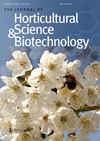温度对单胚和多胚芒果花序发育和性别表达的影响品种
IF 2.1
4区 农林科学
Q2 HORTICULTURE
Journal of Horticultural Science & Biotechnology
Pub Date : 1999-01-01
DOI:10.1080/14620316.1999.11511073
引用次数: 28
摘要
摘要研究了温度对两个单胚芒果品种“欧文”和“感觉”和两个多胚芒果品种“南德麦”和“肯辛顿”花序发育和性别表达的影响。树木在自然冬季温度下诱导开花,然后在15/5、20/10、25/15和30/208℃的昼夜温度下转移到受控环境的温室房间,持续20周。当树木保持在15/58℃时,花序发育没有进展。与生长在25/158摄氏度(23天)和30/208摄氏度(16.1天)的树木相比,较低的温度(20/108摄氏度)延迟了开花时间(42.4天)。在20/108℃时,“感觉”的开花延迟最大(55.5 d),“南德麦”的开花延迟最小(25.5 d),而在其他温度下,品种之间的差异不大。雌雄同体花在花序内的分布不受温度的影响,在花序的顶端部分所占比例最高。在那里……本文章由计算机程序翻译,如有差异,请以英文原文为准。
EFFECT OF TEMPERATURE ON INFLORESCENCE DEVELOPMENT AND SEX EXPRESSION OF MONO- AND POLY-EMBRYONIC MANGO (MANGIFERA INDICA L.) CULTIVARS
SummaryThe effect of temperature on inflorescence development and sex expression in two mono-embryonic (`Irwin' and `Sensation'), and two poly-embryonic (`Nam Dok Mai' and `Kensington') mango cultivars was studied. Trees were subjected to natural winter temperatures to induce flowering prior to transfer into controlled environment glasshouse rooms under day/night temperature regimes of 15/5, 20/10, 25/15 and 30/208C for 20 weeks. Inflorescence development did not progress when trees were held at 15/58C. Cooler temperatures (20/108C) delayed the start of anthesis (42.4.d) compared with trees grown at 25/158C (23.d) and 30/208C (16.1.d). At 20/108C, the delay in the start of anthesis was greatest for `Sensation' (55.5.d) and least for `Nam Dok Mai' (25.5.d) while at other temperatures there was little difference between cultivars. The distribution of hermaphrodite flowers within the inflorescence was independent of temperature with the highest percentage found in the apical half of the inflorescence. There ...
求助全文
通过发布文献求助,成功后即可免费获取论文全文。
去求助
来源期刊
CiteScore
3.90
自引率
5.30%
发文量
67
审稿时长
3 months
期刊介绍:
The Journal of Horticultural Science and Biotechnology is an international, peer-reviewed journal, which publishes original research contributions into the production, improvement and utilisation of horticultural crops. It aims to provide scientific knowledge of interest to those engaged in scientific research and the practice of horticulture. The scope of the journal includes studies on fruit and other perennial crops, vegetables and ornamentals grown in temperate or tropical regions and their use in commercial, amenity or urban horticulture. Papers, including reviews, that give new insights into plant and crop growth, yield, quality and response to the environment, are welcome, including those arising from technological innovation and developments in crop genome sequencing and other biotechnological advances.

 求助内容:
求助内容: 应助结果提醒方式:
应助结果提醒方式:


